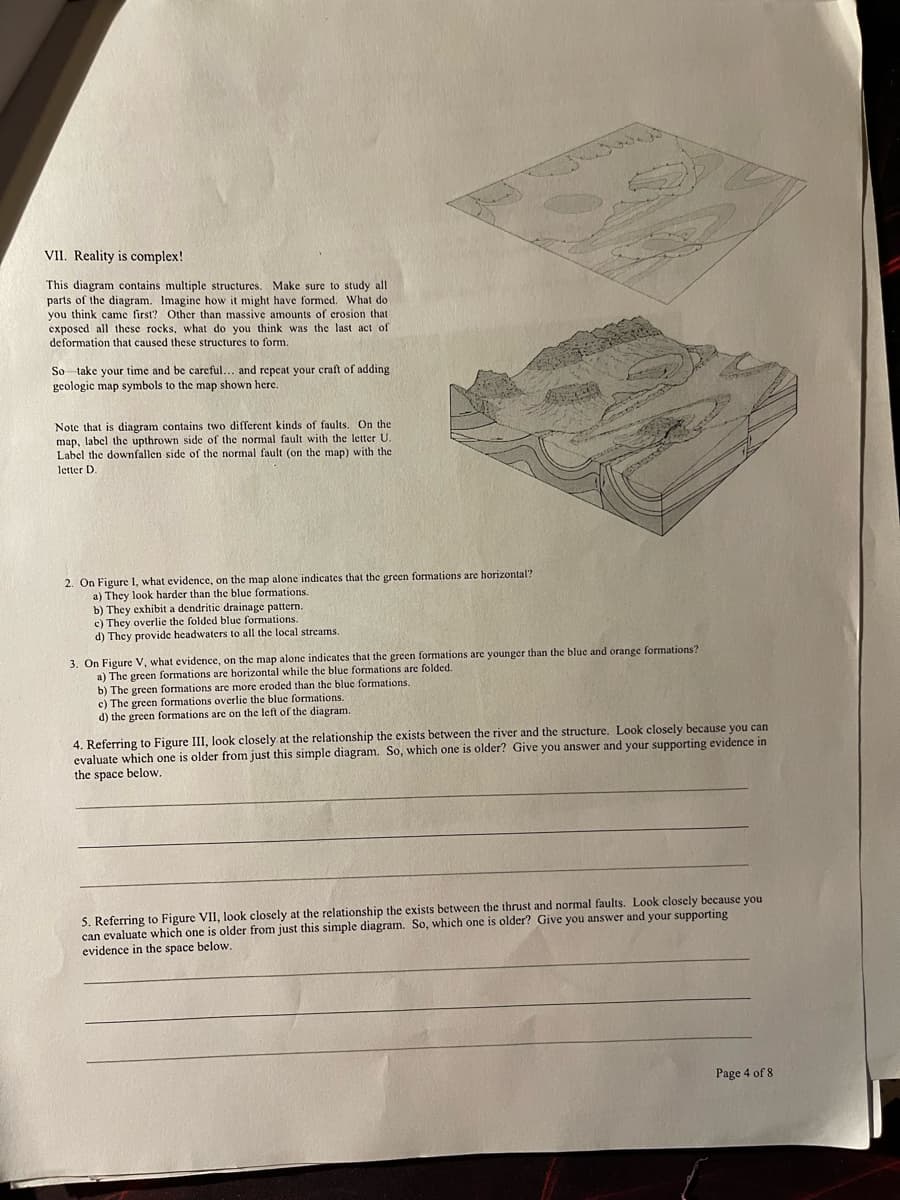3. On Figure V, what evidence, on the map alone indicates that the green formations are younger than the blue and orange formations? a) The green formations are horizontal while the blue formations are folded. b) The green formations are more eroded than the blue formations. c) The green formations overlic the blue formations. d) the green formations are on the left of the diagram. because you can
3. On Figure V, what evidence, on the map alone indicates that the green formations are younger than the blue and orange formations? a) The green formations are horizontal while the blue formations are folded. b) The green formations are more eroded than the blue formations. c) The green formations overlic the blue formations. d) the green formations are on the left of the diagram. because you can
Applications and Investigations in Earth Science (9th Edition)
9th Edition
ISBN:9780134746241
Author:Edward J. Tarbuck, Frederick K. Lutgens, Dennis G. Tasa
Publisher:Edward J. Tarbuck, Frederick K. Lutgens, Dennis G. Tasa
Chapter1: The Study Of Minerals
Section: Chapter Questions
Problem 1LR
Related questions
Question
Answer number 3

Transcribed Image Text:VII. Reality is complex!
This diagram contains multiple structures. Make sure to study all
parts of the diagram. Imagine how it might have formed. What do
you think came first? Other than massive amounts of crosion that
exposed all these rocks, what do you think was the last act of
deformation that caused these structures to form.
So take your time and be careful... and repeat your craft of adding
geologic map symbols to the map shown here.
Note that is diagram contains two different kinds of faults. On the
map, label the upthrown side of the normal fault with the letter U.
Label the downfallen side of the normal fault (on the map) with the
letter D.
2. On Figure I, what evidence, on the map alone indicates that the green formations are horizontal?
a) They look harder than the blue formations.
b) They exhibit a dendritic drainage pattern.
c) They overlie the folded blue formations.
d) They provide headwaters to all the local streams.
3. On Figure V, what evidence, on the map alone indicates that the green formations are younger than the blue and orange formations?
a) The green formations are horizontal while the blue formations are folded.
b) The green formations are more eroded than the blue formations.
c) The green formations overlie the blue formations.
d) the green formations are on the left of the diagram.
4. Referring to Figure III, look closely at the relationship the exists between the river and the structure. Look closely because you can
evaluate which one is older from just this simple diagram. So, which one is older? Give you answer and your supporting evidence in
the space below.
5. Referring to Figure VII, look closely at the relationship the exists between the thrust and normal faults. Look closely because you
can evaluate which one is older from just this simple diagram. So, which one is older? Give you answer and your supporting
evidence in the space below.
Page 4 of 8
Expert Solution
This question has been solved!
Explore an expertly crafted, step-by-step solution for a thorough understanding of key concepts.
Step by step
Solved in 2 steps

Recommended textbooks for you

Applications and Investigations in Earth Science …
Earth Science
ISBN:
9780134746241
Author:
Edward J. Tarbuck, Frederick K. Lutgens, Dennis G. Tasa
Publisher:
PEARSON

Exercises for Weather & Climate (9th Edition)
Earth Science
ISBN:
9780134041360
Author:
Greg Carbone
Publisher:
PEARSON

Environmental Science
Earth Science
ISBN:
9781260153125
Author:
William P Cunningham Prof., Mary Ann Cunningham Professor
Publisher:
McGraw-Hill Education

Applications and Investigations in Earth Science …
Earth Science
ISBN:
9780134746241
Author:
Edward J. Tarbuck, Frederick K. Lutgens, Dennis G. Tasa
Publisher:
PEARSON

Exercises for Weather & Climate (9th Edition)
Earth Science
ISBN:
9780134041360
Author:
Greg Carbone
Publisher:
PEARSON

Environmental Science
Earth Science
ISBN:
9781260153125
Author:
William P Cunningham Prof., Mary Ann Cunningham Professor
Publisher:
McGraw-Hill Education

Earth Science (15th Edition)
Earth Science
ISBN:
9780134543536
Author:
Edward J. Tarbuck, Frederick K. Lutgens, Dennis G. Tasa
Publisher:
PEARSON

Environmental Science (MindTap Course List)
Earth Science
ISBN:
9781337569613
Author:
G. Tyler Miller, Scott Spoolman
Publisher:
Cengage Learning

Physical Geology
Earth Science
ISBN:
9781259916823
Author:
Plummer, Charles C., CARLSON, Diane H., Hammersley, Lisa
Publisher:
Mcgraw-hill Education,